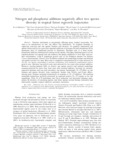Use este identificador para citar ou linkar para este item:
http://www.alice.cnptia.embrapa.br/alice/handle/doc/871754| Título: | Nitrogen and phosphorus additions negatively affect tree species diversity tropical forest regrowth trajectories. |
| Autoria: | SIDDIQUE, I.  VIEIRA, I. C. G.   SCHIMIDT, S.   LAMB, D.   CARVALHO, C. J. R. de   FIGUEIREDO, R. de O.   BLOMBERG, S.   DAVIDSON, E. A.   |
| Afiliação: | YLYAS SIDDIQUE, Universidade of Queensland; IMA CÉLIA GUIMARÃES VIEIRA, Museu Paraense Emílio Goeldi; SUSANE SCHIMIDT, University of Queesland; DAVID LAMB, University of Queensland; CLAUDIO JOSE REIS DE CARVALHO, CPATU; RICARDO DE OLIVEIRA FIGUEIREDO, CPATU; SOMON BLOMBERG, University of Quuensland; ERIC A. DAVIDSON, Woods Hole Research Center. |
| Ano de publicação: | 2010 |
| Referência: | Ecology, v. 91, n. 7, p. 2121-2131, 2010. |
| Conteúdo: | Nutrient enrichment is increasingly affecting many tropical ecosystems, but there is no information on how this affects tree biodiversity. To examine dynamics in vegetation structure and tree species biomass and diversity, we annually remeasured tree species before and for six years after repeated additions of nitrogen (N) and phosphorus (P) in permanent plots of abandoned pasture in Amazonia. Nitrogen and, to a lesser extent, phosphorus addition shifted growth among woody species. Nitrogen stimulated growth of two common pioneer tree species and one common tree species adaptable to both high- and lowlight environments, while P stimulated growth only of the dominant pioneer tree Rollinia exsucca (Annonaceae). Overall, N or P addition reduced tree assemblage evenness and delayed tree species accrual over time, likely due to competitive monopolization of other resources by the few tree species responding to nutrient enrichment with enhanced establishment and/or growth rates. Absolute tree growth rates were elevated for two years after nutrient addition. However, nutrient-induced shifts in relative tree species growth and reduced assemblage evenness persisted for more than three years after nutrient addition, favoring two nutrientresponsive pioneers and one early-secondary tree species. Surprisingly, N þ P effects on tree biomass and species diversity were consistently weaker than N-only and P-only effects, because grass biomass increased dramatically in response to N þ P addition. The resulting intensi?ed competition probably prevented an expected positive N þ P synergy in the tree assemblage. Thus, N or P enrichment may favor unknown tree functional response types, reduce the diversity of coexisting species, and delay species accrual during structurally and functionally complex tropical rainforest secondary succession. |
| Thesagro: | Nitrogênio Floresta tropical Fósforo |
| Tipo do material: | Artigo de periódico |
| Acesso: | openAccess |
| Aparece nas coleções: | Artigo em periódico indexado (CPATU)  |
Arquivos associados a este item:
| Arquivo | Descrição | Tamanho | Formato | |
|---|---|---|---|---|
| Nitrogenclaudio.pdf | 614,22 kB | Adobe PDF |  Visualizar/Abrir |









